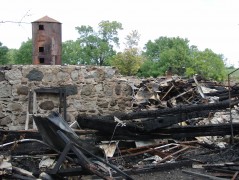There are still curls of smoke rising from what remains of Howard Summerhayes’ barn. The fire trucks came and went over a week ago and there is nothing much left of the 170-year-old structure but the fire just won’t give up — much like Howard.
As with most people that become water activists, Howard once assumed that various levels of government were protecting the water that is so fundamental to our well being. But that changed about 12 years ago when his field drainage system was badly damaged by storm water runoff from a new subdivision. In the messy aftermath of that incident, Howard realized that neither the regulations nor the regulators were very robust. He has been asking questions, intervening, educating, networking and inspiring people ever since. He does it face to face, on the telephone and in carefully hand-written letters. No computers, no email. He has made many new friends and allies in the years since that storm but he has also been an obstacle for those who have other plans for the water. As Maude Barlow’s mother says, “Serious people have serious enemies”.
Howard’s farm on the outskirts of Brantford has been in the Summerhayes family since the 1800s. The last few decades have seen thousands of acres of surrounding farmland lost to urban sprawl but Howard has turned down all offers to buy him out. He loves to farm and at 76 years old, he is still in good enough shape to manage his property. But the gleam in his eye now comes from his new love, fighting to protect the water, and there is a lot of water to love in Howard’s neighbourhood.
This part of Southern Ontario contains rare and extraordinary land and water features. You can find the more obvious ones like Jones Creek, Fairchild’s Creek and the Grand River on any decent map but you have to take a walk with Howard and some of the local folks he works with to find the hidden gems in this water wonderland. That’s what I did this past July with Maude and a group of researchers from the University of Guelph.
Our tour included a perched, non-acidic, fresh water fen (only one other is known to exist in North America), pressure cones created by cold water geysers, some of the finest Carolinian forest in the province and tufa mounds. Tufa is a type of rock formed as a result of the precipitation of limestone. Its presence alone was enough to earn the location an ANSI designation as an area of natural and scientific interest. Cold water springs are plentiful as well and the source of many of them is a powerful underground river that is believed to connect Lake Huron to Lake Ontario. There is also a rich First Nations culture and history throughout these lands.
Twelve years ago, Howard Summerhayes never imagined he would one day be a water warrior, talking to people like Maude Barlow and hosting university researchers. That disastrous night when his drains were blown out pointed him down a peculiar path. While the cause of the fire that destroyed his barn is unknown, Howard is not about to give up. He is currently planning how to run his farm without using a barn and he thinks the fire might end up being a blessing in disguise. That is the kind of grit and determination that every activist needs. In Howard, the water has a serious friend.



